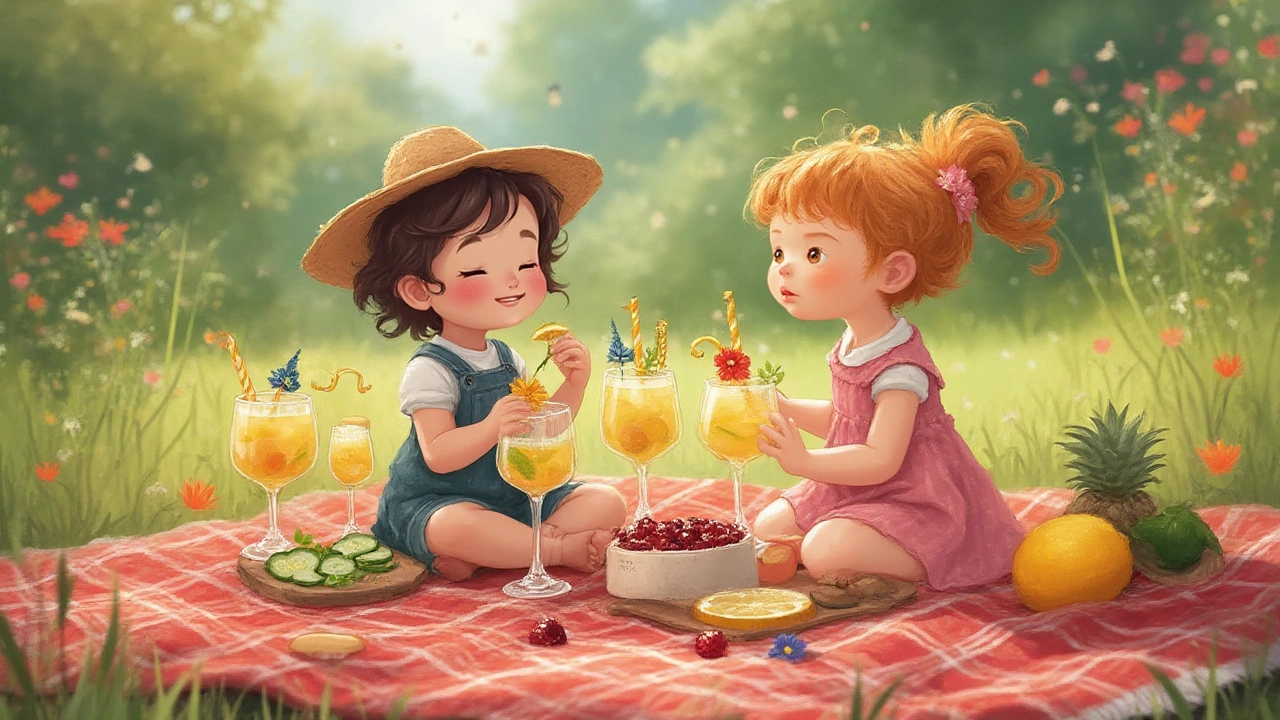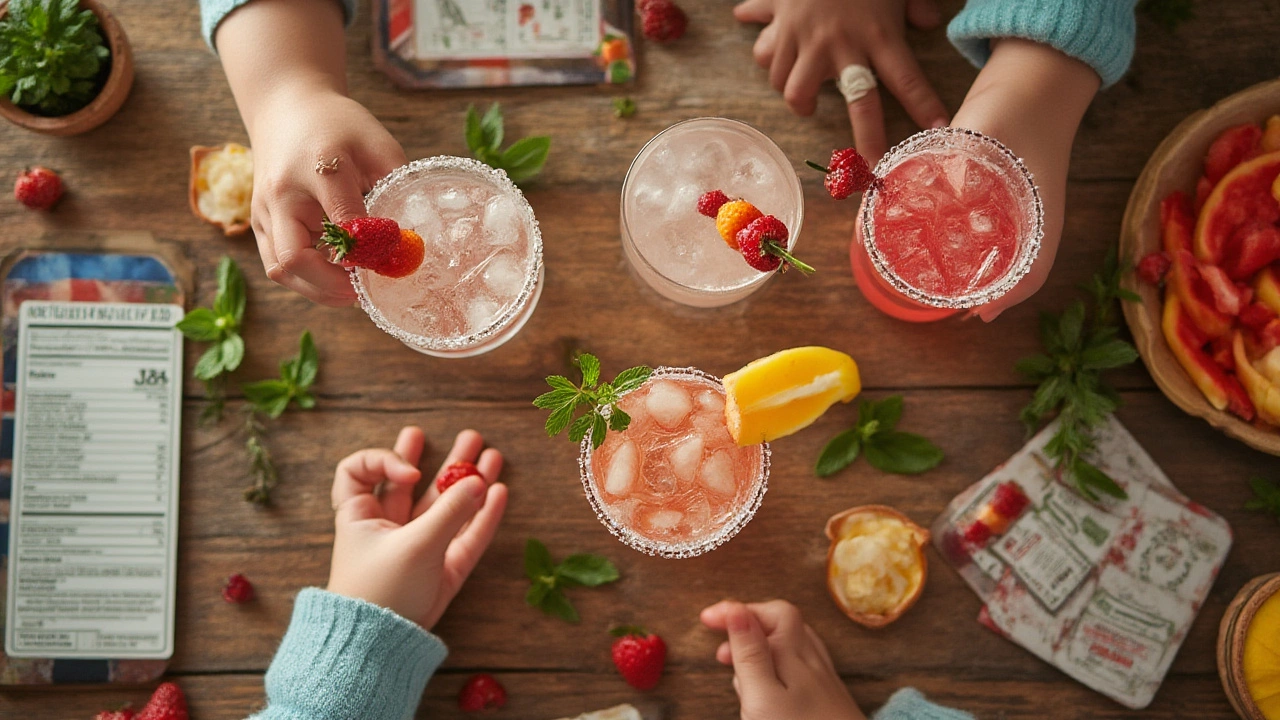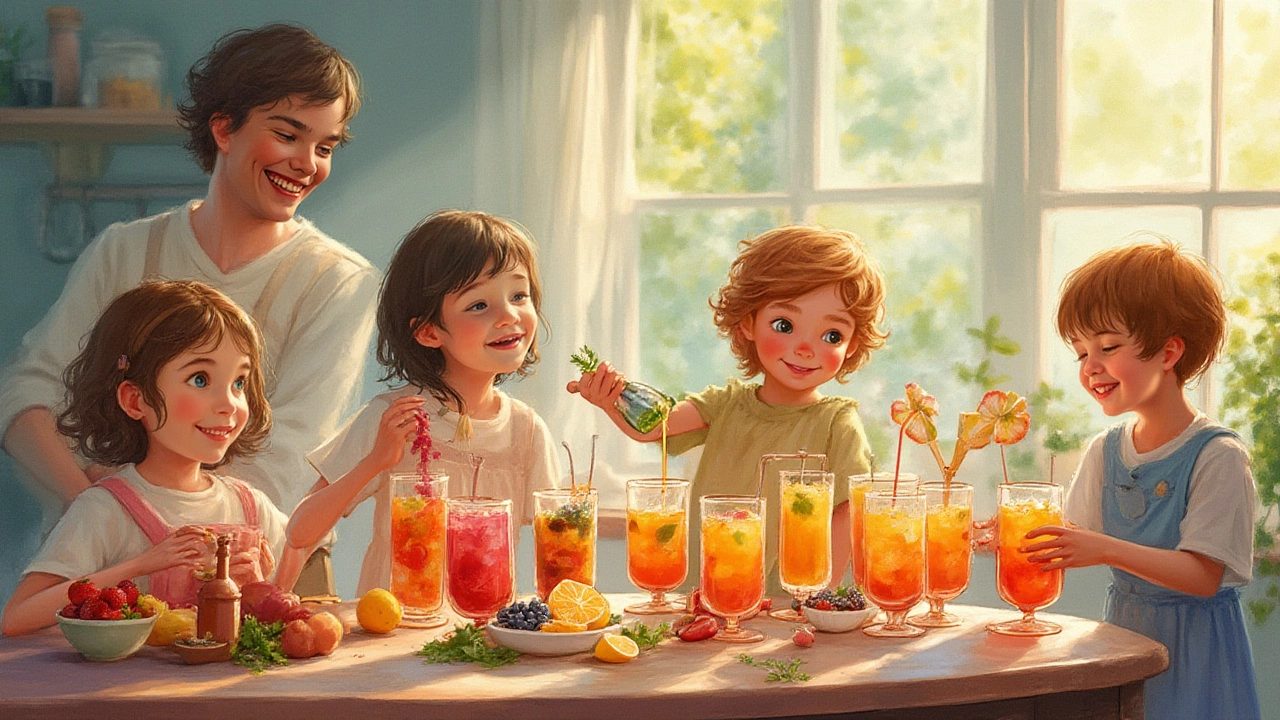Picture a birthday party: balloons, grins, noise, and on the table—a rainbow of drinks topped with fruit and tiny umbrellas. The kids go wild for these drinks. But wait, someone asks, “Can kids drink mocktails?” Instinct says yes. They seem harmless—no alcohol, lots of color, and they taste sweet. But is there more to it? Let’s peel back the label on the world of mocktails for kids, from safety and sugar content to smart alternatives and the real deal when it comes to letting little hands hold fancy glasses.
What Exactly Is a Mocktail? Unpacking the Basics
Mocktails started as the grown-up’s solution for skipping booze without missing out on social fun. The word itself is a mashup—mixing “mock” (to mimic) and “cocktail.” Strip the alcohol, keep the zest, and boom: you’ve got a mocktail. These drinks use juices, fizzy water, fresh fruit, syrups, and sometimes even non-alcoholic bitters or botanical blends. At first, they were mostly for adults at fancy parties or the designated driver who still wanted a special glass in their hand. But lately, mocktails have hit the mainstream—spilling over into family gatherings and kids’ menus at trendy restaurants.
How are mocktails served up? Often they mirror their boozy cousins, just minus any trace of alcohol. Think piña colada without rum, mojito with no gin—lots of ice, fruit, mint, and sometimes a big wedge of citrus. They’re fun and flashy, which makes them a magnet for children who want to join the grown-up vibe. Marketing for mocktails now goes right out of its way to be flashy: bright labels, cartoonish garnishes, and sugar-rimmed glasses. You’ll spot them at kid-centric events—school fairs, pool parties, movie nights—or even on sleepover menus. The line between fun treat and grown-up mimic is pretty thin. That sometimes gives parents pause: is this harmless play, or something worth being careful about?
At their core, mocktails are, by ingredient list, just non-alcoholic drinks. That could mean a blend of just fruit juices and sparkling water, or it could be much more complicated with specialty flavored syrups and, sometimes, non-alcoholic bitters or mixers that are lab-created to resemble traditional spirits. No ethanol equals no drunkenness, obviously. But zero alcohol doesn’t always mean zero risk. The real question comes down to: what’s in the glass, and how does it fit with a child’s nutrition, habits, and setting? We’ll come back to that, but keep in mind: not every mocktail is the same. Some are glorified juice, some pack as much sugar as a cola, and others have extras that might not be great for developing bodies.
One big reason mocktails are so tempting for kids is presentation. Who wouldn’t want a blue raspberry “sea splash” with a sparkler or a plastic sword popping out? But sometimes the visuals can distract from what’s actually in the drink. And while adults order mocktails for the taste and style, kids might like them mostly for looks and the feeling of being part of something special. If you’re thinking about letting your kids go wild at the mocktail bar, what exactly are you handing them? Time to look closer at what’s in these pint-sized party drinks—because not everything with a little umbrella is created equal.
Mocktails on the market now can range from bottled sodas labeled “virgin mojito” to homemade juice blends over ice. A 2023 survey by the International Food Information Council found nearly 36% of parents in the US have served mocktails to kids at home or at parties. That’s a big jump up from 22% in 2020—proof of just how trendy these drinks have become. So, the cat’s out of the bag: kids already have access. The big thing is, should they?

Are Mocktails Safe for Children? Nutrition, Health, and Social Signals
Start with the obvious: mocktails don’t have alcohol, so you won’t need to worry about accidental intoxication. But drinking them still isn’t always a slam dunk. The National Center for Health Research points out that most mocktails aren’t much more than juices, flavored syrups, and sodas with photogenic garnishes. Here’s where it gets tricky: these drinks can sometimes pour more sugar than a can of soda. For kids, that’s an issue. The American Heart Association says children ages 2–18 should have less than 25 grams of added sugar a day. Some mocktails load up 30–40 grams in a single glass. Imagine inviting your whole soccer team over and dishing up two rounds—hello, sugar rush (and not in a fun way).
So what about nutrition? You’re usually dealing with a mix of fruit juices, which have vitamins and minerals but also high natural sugar content. Bottled mixers can carry artificial colors and flavors. Natural doesn’t always mean healthy—especially when portion sizes get out of control. Watered-down juice or a spritz of fresh fruit seltzer is one thing; a glass topped with whip and marshmallows is another beast. If your kid is used to water or plain milk, a mocktail is basically hitting their system with a wallop of sweetness. Frequent mocktail consumption doesn’t help healthy teeth, either. Pediatric dentists see the fallout of high-sugar diets in cavities and enamel wear. Those neon-tinted frozen “slushie mocktails” are double trouble—sugar and acidic flavorings that can eat away delicate enamel.
There’s also a social angle here that a lot of people don’t talk about. Giving mocktails to kids isn’t just about what’s in the glass—it’s about how kids see drinking, period. When kids start associating “special treats” or “celebrations” with cocktail-like glasses, it can blur the line between having fun and copying adult rituals. One Harvard University study highlighted how modeling adult behaviors—even unintentionally—sets up long-term signals about drinking culture. If “grown-up parties” always involve elaborate drinks (even booze-free), it can link the idea of drinking to fun, excitement, and belonging.
You might ask: is it really a big deal if a five-year-old drinks a sparkly, alcohol-free “mocktail” at their birthday party? Short term, maybe not—one-off sugar hit, happy memories, big smiles. But if it becomes a tradition, or the drinks become hard to distinguish from their boozy namesakes, it gets murky. Some parenting forums tell stories of six-year-olds sipping “virgin daiquiris” and wanting to clink glasses for New Year’s right next to the adults. Kids imitate what they see. That’s not all bad—imitation is behind learning to tie shoes and say thank you—but it pays to be honest about the messages party habits can send.
| Mocktail | Approximate Sugar (g) |
|---|---|
| Virgin Piña Colada | 38 |
| Shirley Temple | 30 |
| Virgin Mojito | 18 |
| Fruit Punch | 26 |
| Orange Cream Soda | 32 |
But let’s not be alarmist. Serving a mocktail here and there won’t ruin anyone’s health. The secret is moderation and ingredient choice. Ditch heavy syrups and all the extras for fresh fruit purees, diluted juice, or sparkling water as a base. Subbing in real fruit slices for gummy garnishes? Big win. And don’t forget about allergies—always double-check labels if you’re using store-bought mixers, especially with guests. Another tip: if you make drinks at home, get the kids involved in choosing and chopping the fruit. It takes the focus off “fancy drinking” and puts the spotlight on flavor creation, teamwork, and learning about what goes into food.
What about the rare non-alcoholic bitters or mixers in some “craft” mocktails aimed at adults? Most are safe, but check for ingredients not meant for kids, like caffeine or herbal extracts. If you’d never let your eight-year-old down a Red Bull, skip anything with stimulants—some mocktail-ready sodas and energy syrup mixers sneak caffeine in. And if you’re ever unsure, ask your pediatrician, especially if your child has health issues like diabetes or is prone to dental problems.
Mocktails don’t need to be forbidden, but it’s wise to keep them as treats, not everyday fare. Swap sugary mixers for honest flavors like muddled berries, citrus, cucumber, maybe some fresh mint from the herb pot. At my place, Max (my dog) tries to grab stray berries every time we’re making “firecracker fizz”—but the kids come running too. We do “blind taste test” stations, and they always laugh more at the flopped flavors than the most rainbow-glitter drink. You can give kids the special event vibes without piling on sugar or social confusion. Mocktails can be a gateway to conversations about food, fun, and healthy choices, if you’re thoughtful about it.

Best Practices for Serving Mocktails to Kids: Tips, Ideas, and Family-Friendly Recipes
If you’re set on letting mocktails be part of your next birthday, barbecue, or rainy-day family kitchen adventure, a little planning goes a long way. The basic rule: keep it simple, low in sugar, and always supervised. To help you out, here are my go-to tips for serving mocktails to kids in a way that’s both safe and fun.
- Choose real, simple ingredients: Use juice diluted with water, plain seltzer, or coconut water for a lighter touch. Fresh pressed juice is better than anything bottled with added sugar.
- Limit sugar and don’t overdo the portions. Remember, an 8oz glass is plenty. If the mocktail is more dessert than drink, serve smaller cups.
- Skip the energy drinks, caffeinated sodas, or mixes containing bitters unless you’re 100% sure it’s kid-friendly. Read labels and stick to stuff you can pronounce.
- Focus on the fun: jazz up drinks with fruit slices, umbrellas, or colored paper straws instead of loading them with syrup. Presentation can be play, too.
- Keep clear that these are special treats—not for every meal or day. That keeps both the habit and the sugar content in check.
- Get kids involved in picking flavors. Turn it into a game—taste tests, naming new recipes, or “design your own” stations where everyone builds their own cup.
- If the party has older teens, keep mocktails obviously distinct from real cocktails. Nobody needs confusion at family events. Color-coding glasses or keeping separate stations helps.
- Always supervise. Make sure mocktails are the only drinks being mixed and passed around—no chance for mistakes.
- Talk openly with kids about why adults sometimes have different drinks. The conversation keeps “drinking” from becoming mysterious or forbidden—which is when curiosity can get risky later.
Need fresh ideas? Here are three fast, family-tested recipes that please every crowd (and get both “oohs” and “aahs” from the under-10 set):
- Berry Splash: Muddle blackberries and raspberries in a glass, add a splash of apple juice, fill with sparkling water, and add lots of ice. Garnish with a twist of lemon.
- Minty Orange Spritz: Combine 2 parts orange juice, 3 parts seltzer water, a spoonful of honey (if you want it sweet), and some torn mint leaves. Serve over crushed ice with an orange slice to top.
- Pineapple Coconut Cooler: Mix equal parts pineapple juice and coconut water. Add a squeeze of lime and pour over ice. Drop in a cherry for extra flair.
If you want to set up a DIY mocktail bar for your next kid-friendly event, offer a few base options: lightly sweetened teas, fruit purees, fizzy mineral water, fresh herbs, and bowls of sliced fruit for garnishes. Kids love having “ownership” over what goes in the glass, and they’ll often pick more fruit and less syrup when they’re in charge. My own nieces and nephews used to fight over who could crush the mint for the “lucky green lemonade”—now they team up, comparing notes like little chefs.
Want to add a dash of education? You can do a “sugar reveal” by showing the sugar content of typical mocktail mixers versus natural fruit. Letting kids see and taste the difference gives them a leg up on making good choices later. You can keep the party going without a crash if you focus on real flavors and special moments, not just turning every family gathering into a sugar-laden spectacle.
So, can kids drink mocktails? Yes, but with smart limits, real ingredients, and open eyes. Celebrate the moments, not just the glasses, and you’ll end up with fewer sugar crashes, better memories, and a family table everyone wants to come back to. And if you’re ever unsure, pour another round of fizzy water, watch the dance parties, and leave the complicated concoctions for the grown-ups. Max will still try to steal the berries—but the laughs are always the best part anyway.


